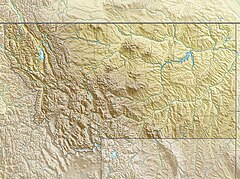Ruby River
| Ruby River | |
|---|---|
 Fly Fisherman on the Ruby River | |
 Location of mouth | |
| Location | |
| Country | United States |
| State | Montana |
| Physical characteristics | |
| Mouth | |
• coordinates | 45°31′13″N 112°20′25″W / 45.52028°N 112.34028°WCoordinates: 45°31′13″N 112°20′25″W / 45.52028°N 112.34028°W[1] |
• elevation | 4,642 feet (1,415 m)[1] |
| Length | 76 miles (122 km) |
| Basin size | Snowcrest Range and Gravelly Range |
| Discharge | |
| • location | near Twin Bridges |
| • average | 199 cu ft/s (5.6 m3/s)[2] |
| Basin features | |
| River system | Missouri River |



The Ruby River is a tributary of the Beaverhead River, approximately 76 mi (122 km) long, in southwestern Montana in the United States. It rises in the Beaverhead National Forest in southwestern Madison County between the Snowcrest Range and the Gravelly Range. It flows north through the , past Alder, then northwest, flowing between the Tobacco Root Mountains to the northeast and the Ruby Range to the southwest. It joins the Beaverhead near Twin Bridges. The Beaverhead becomes the Jefferson River 2 mi (3.2 km) downstream where it joins the Big Hole River.
The river has also been known by these various names: Pah-mamar-roi, Pak-sam-ma-oi, Pashmaroi, Passamari, Philanthropy River, Stinking Water Creek, Stinking Water River, Stinkingwater River.[1]
The Ruby is a Class II river for stream access for recreational purposes.[3]
Ruby River angling[]
The Ruby River provides excellent fly fishing for anglers despite some battles with whirling disease and a massive fish kill in the lower stretches in 1994.
The upper stretch of the river, above Ruby Reservoir, has excellent fly fishing for rainbows, cutthroats and grayling. The lower stretch of the river, below Ruby Dam, provides excellent brown trout fishing. The average size of browns runs between 10-14 inches, with some fish reaching 18-20 inches. Because of limited access, fishing pressure on the lower river varies. Along private stretches, the river is rarely fished. Most of the angling is done at the few state access sites below the dam. This can cause significant crowding along those stretches, especially during the summer months.[4]
Advocates[]
- Jefferson River Watershed Council — The mission of the Jefferson River Watershed Council is to coordinate efforts, through a spirit of community cooperation and sharing, that will enhance, conserve, and protect the natural resources, quality of life, and economic vitality of the Jefferson River watershed.[5]
- Trout Unlimited — Trout Unlimited's mission is to conserve, protect and restore North America's coldwater fisheries and their watersheds.[6]
- Western Watersheds Project — The mission of is to protect and restore western watersheds and wildlife through education, public policy initiatives and litigation.[7]
- Montana River Action — The clean flowing waters of Montana belong to the people and are held in trust by the State for a pollution-free healthful environment guaranteed by our Montana Constitution. Montana River Action's mission is to protect and restore rivers, streams and other water bodies.[8]
- Public Land/Water Access Association - The mission of the association is to maintain, restore, and perpetuate public access to the boundaries of all Montana public land and waters[9]
- Montana Trout Stalkers - Offers Ruby River Guide Trips and advocates stream access for the public and conservation of a great fishery[10]
See also[]
References[]
- ^ Jump up to: a b c "Ruby River". Geographic Names Information System. United States Geological Survey.
- ^ https://waterdata.usgs.gov/mt/nwis/annual/?format=sites_selection_links&search_site_no=06023000&agency_cd=USGS&referred_module=sw
- ^ Stream Access in Montana Archived 2009-03-10 at the Wayback Machine
- ^ Ruby River Fly Fishing
- ^ Jefferson River Watershed Council Website Archived 2012-02-08 at the Wayback Machine
- ^ Trout Unlimited website
- ^ Western Watersheds Project website
- ^ Montana River Action Website
- ^ Public Land/Water Access website
- ^ Montana Trout Stalkers Website
| Wikimedia Commons has media related to Ruby River. |
- Rivers of Montana
- Tributaries of the Beaverhead River
- Bodies of water of Madison County, Montana

